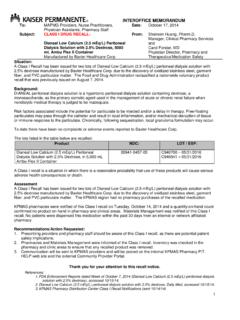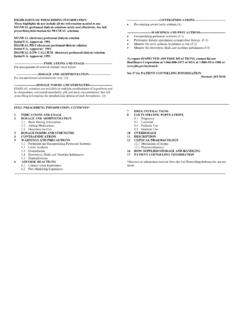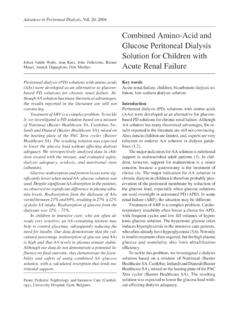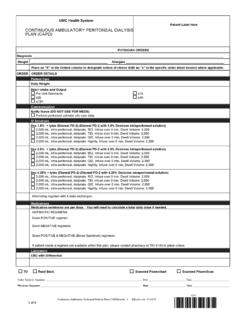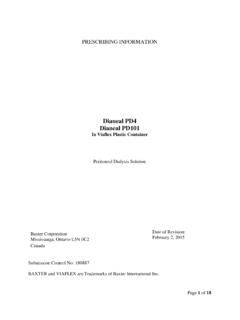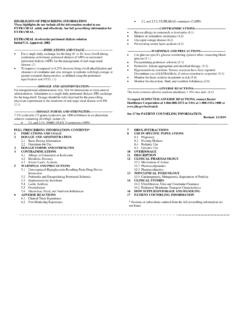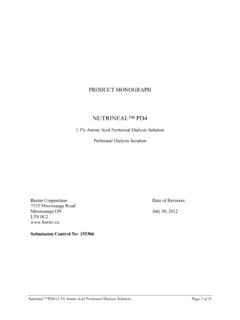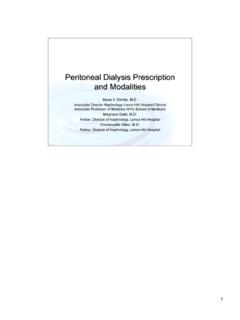Transcription of PHYSIONEAL 40 GLUCOSE SOLUTION FOR …
1 PHYSIONEAL 40 glucose solution for peritoneal dialysis Product Information PHYSIONEAL PI_Ver04 Page 1 of 12 PHYSIONEAL 40 glucose solution for peritoneal dialysis Name of the Medicine: PHYSIONEAL 40 GLUCOSE (%) SOLUTION for peritoneal dialysis PHYSIONEAL 40 GLUCOSE w/v / mg/mL SOLUTION for peritoneal dialysis PHYSIONEAL 40 GLUCOSE w/v / mg/mL SOLUTION for peritoneal dialysis PHYSIONEAL 40 GLUCOSE w/v / mg/mL SOLUTION for peritoneal dialysis Description: PHYSIONEAL 40 is a sterile, clear, colourless SOLUTION . Composition: Composition of the SOLUTION in each compartment before mixing in g/L Viaflex Bag Clear Flex Bag GLUCOSE GLUCOSE GLUCOSE GLUCOSE GLUCOSE GLUCOSE GLUCOSE Bag A Anhydrous GLUCOSE Calcium Chloride (Dihydrate) Magnesium Chloride (Hexahydrate) Buffer Bag B Sodium Chloride Sodium Bicarbonate Sodium Lactate Final SOLUTION After Mixing g/L Anhydrous GLUCOSE Sodium Chloride Calcium Chloride (Dihydrate) Magnesium Chloride (Hexahydrate) Sodium Bicarbonate Sodium Lactate 1000 mL of final SOLUTION after mixing corresponds to: Viaflex Bag: mL of SOLUTION A ( GLUCOSE ) and mL of SOLUTION B (Buffer).
2 Clear Flex Bag: 750 mL of SOLUTION A ( GLUCOSE ) and 250 mL of SOLUTION B (Buffer). The pH of the final SOLUTION is Hydrochloric acid ( SOLUTION A) and Sodium hydroxide ( SOLUTION B) are used for pH adjustment in the Clear Flex presentation. Composition of the final SOLUTION after mixing in mmol/L GLUCOSE GLUCOSE GLUCOSE Anhydrous GLUCOSE (C6H12O6) Sodium (Na+) Calcium (Ca++) Magnesium (Mg++) Chloride (Cl-) Bicarbonate (HCO3-) Lactate (C3H5O3-) 132 95 25 15 126 132 95 25 15 214 132 95 25 15 Osmolarity* 344 mOsmol/L 395 mOsmol/L 483 mOsmol/L PHYSIONEAL 40 glucose solution for peritoneal dialysis Product Information PHYSIONEAL PI_Ver04 Page 2 of 12 *Osmolarity is equivalent to osmolality in infinitively diluted conditions, including total dissociation of ingredients.
3 Pharmacology: Pharmacodynamic properties For use in patients with renal failure to aid the regulation of fluid and electrolytes as well as acid base balances. This procedure is accomplished by administering peritoneal dialysis fluid through a catheter into the peritoneal cavity. Transfer of substances between the patient's peritoneal capillaries and the dialysis fluid is made across the peritoneal membrane according to the principles of osmosis and diffusion. After dwell time, the SOLUTION is saturated with metabolic substances and must be changed. With the exception of lactate, present as a bicarbonate precursor, electrolyte concentrations in the fluid have been formulated in an attempt to normalise plasma electrolyte concentrations. Nitrogenous waste products, present in high concentration in the blood, cross the peritoneal membrane into the dialysis fluid. GLUCOSE produces a SOLUTION hyperosmolar to the plasma, creating an osmotic gradient which facilitates fluid removal from the plasma to the SOLUTION .
4 Pharmacokinetic properties Intraperitoneally administered GLUCOSE , buffer, electrolytes and water are absorbed into the blood and metabolised by the usual pathways. GLUCOSE is metabolised (1 g of GLUCOSE = 4 kilocalories or 17 kilojoules) into CO2 and H2O. Clinical Trials: To date a total of 226 patients have been exposed to PHYSIONEAL 40 in a total of 6 controlled clinical trials. The exposure time ranged from single dwells (18 patients) to up to one year s exposure (70 patients in 6 month study, 43 continued for full year). No pregnant or lactating women or children were studied and there is no long-term survival data. Most of the trials were designed to demonstrate equivalence with the control product. In all studies there were no significant changes in the residual renal function (RRF), weekly Kt/V and normalised creatinine clearances when patients switched from dianeal PD4 to PHYSIONEAL 40, and no statistically significant differences between the control ( dianeal PD4) arms of these studies and the PHYSIONEAL 40 arms.
5 Ultrafiltration is maintained when the buffer is changed from pure lactate to a bicarbonate/lactate combination. There was no difference between PHYSIONEAL 40 and dianeal PD4 with regard to maintenance of calcium and magnesium homeostasis. Acid-base homeostasis was assessed from measurement of the plasma bicarbonate. In all studies the change from baseline (or between group differences) was always within the pre-defined equivalence targets. PHYSIONEAL thus corrects acidosis as well as dianeal . There did not seem to be any obvious trends across the various PHYSIONEAL 40 trials regarding deaths or withdrawals due to adverse events. PHYSIONEAL 40 glucose solution for peritoneal dialysis Product Information PHYSIONEAL PI_Ver04 Page 3 of 12 PIVOTAL STUDIES REP-RENAL-REG-029 Study design Randomised, open-label, comparative study to assess the bioequivalence of a bicarbonate based peritoneal dialysis [bicarb/lactate 25/15mmol/L] SOLUTION compared to lactate (40mmol/L) buffer SOLUTION .
6 Primary Variable Plasma bicarbonate levels. The two preparations were considered equivalent if the 90% confidence intervals for the treatment difference fell entirely within Results Base line demographics and plasma bicarbonate levels for subjects in study REP-RENAL-REG-029 REP-RENAL-REG-029 ITT population Control PHYSIONEAL Total No. Randomised 36 70 Mean Age (yrs) Range 23 76 26 77 Gender % Males 50 60 Previous peritonitis (% subjects) Duration of dialysis at baseline (yrs) Duration of CADP at baseline (yrs) Bicarbonate at baseline mmol/L (SD) ( ) ( ) Bicarbonate at 3 months (SD) ( ) ( ) Treatment difference (90% Cl , ) Bicarbonate at 6 months (SD) ( ) ( ) Treatment difference (90% Cl , )
7 After three to six months there were small statistically significant treatment differences in plasma bicarbonate levels. 90% of confidence intervals for the treatment differences were within 3mmol/L of bicarbonate and the treatments are considered to be equivalent. There were no statistically significant correlations between bicarbonate levels and age or normalised Residual Renal Function at 6 months for either treatment, but there was a significant negative correlation between calcium carbonate dose and bicarbonate levels in the PHYSIONEAL group. Subjects treated with PHYSIONEAL recorded significantly more alkalosis events than those treated with the lactate (40mmol/L) buffer SOLUTION . REP-RENAL-REG-030-A Study design Study designed to subjectively evaluate inflow pain during CAPD with a 28mM bicarbonate SOLUTION , PHYSIONEAL and dianeal in 18 subjects who had previously experienced pain during PHYSIONEAL 40 glucose solution for peritoneal dialysis Product Information PHYSIONEAL PI_Ver04 Page 4 of 12 dialysis treatment.
8 This was a single-blind, randomised crossover study where pain was assessed during two single infusions of each SOLUTION over a one to three week period, with each participant receiving six single infusions in random order. Test solutions were: bicarbonate 38mM (pH ); Bicarbonate lactate 25/15 mM (pH ) and dianeal PD4 (40mM lactate) (pH ). All three solutions contained GLUCOSE in a two-litre bag. Primary Variable The primary endpoint variable was pain during the infusion and subjects were evaluated over a three hour period that included the dwell and drain times of the SOLUTION . Pain severity was measured on a five-point visual analogue scale (none, mild, moderate, severe and very severe). The McGill Pain Questionnaire (MPQ) was used to assess the pain severity / intensity and provide verbal descriptors of pain. Results Baseline demographics and subjective pain scores (range 0 5) for subjects in study REP-RENAL-REG-030A REP-RENAL-REG-030 A ITT population Total No.
9 Randomised 18 Mean Age (yrs) Range 27 - 75 Gender % Males56 Previous peritonitis in last 6 months(% subjects)50 Duration of dialysis at baseline (mean yrs) Evaluablepopulation dianeal Bicarb. PHYSIONEAL P value Total No. of infusions 34 34 34 Peak pain score during infusion (Range) (0-3) (0-3) (0-2) Treatment difference PHYSIONEAL vs dianeal PD4 Peak pain score during dwell (Range) (0-3) (0-3) (0-2) Treatment difference PHYSIONEAL vs dianeal PD4 Peak pain score during drain (Range) (0-1) (0-3) (0-2) Treatment difference There was a statistically significant treatment difference in peak pain scores during the infusions (P= ). PHYSIONEAL SOLUTION produced lower pain scores than dianeal . However, this difference has not been confirmed from larger studies. Numerous variables could affect pain related to the dialysis procedure (including ones related to the dialysis SOLUTION , such as catheter placement, that can affect the validity of clinical trials).
10 Indications: PHYSIONEAL 40 is indicated for use in peritoneal dialysis in patients with acute or chronic renal failure. PHYSIONEAL 40 glucose solution for peritoneal dialysis Product Information PHYSIONEAL PI_Ver04 Page 5 of 12 Contraindications: PHYSIONEAL is contraindicated for use in patients with: Uncorrectable mechanical defects that prevent effective peritoneal dialysis or increase the risk of infection Documented loss of peritoneal function or extensive adhesions that compromise peritoneal function. Precautions: Product is for single use in one patient only. Encapsulating peritoneal Sclerosis (EPS) is considered to be known, rare complication of peritoneal dialysis therapy.
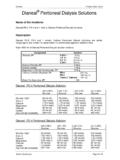
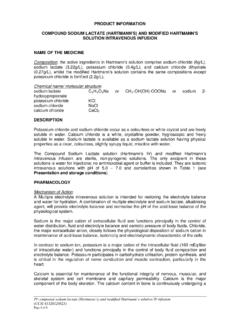
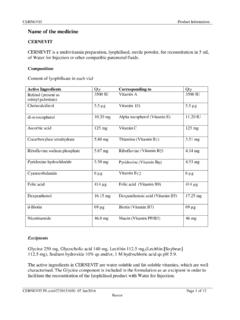
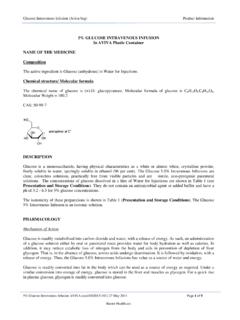
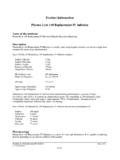
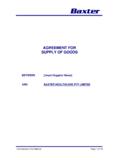
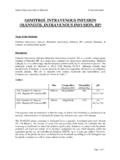
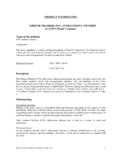
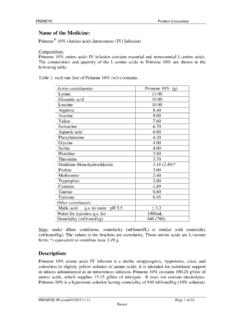
![T I S S E E L [Fibrin Sealant] - Baxter Healthcare](/cache/preview/5/e/c/8/3/b/b/2/thumb-5ec83bb2d349410260af6c556ae67fe3.jpg)
